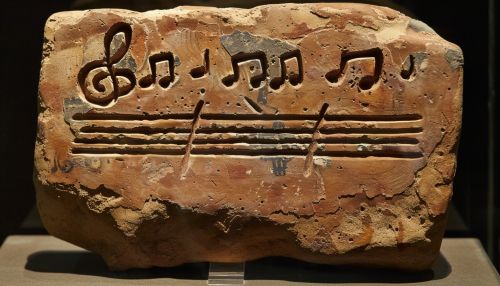Musical notation
History of Musical Notation
Musical notation has a rich and complex history that spans thousands of years. The earliest form of musical notation can be traced back to the Sumerian civilization in Mesopotamia around 2000 BC, where clay tablets have been found with cuneiform inscriptions of musical instructions.


The Greeks developed their own system of notation around the 6th century BC, using letters of the Greek alphabet to represent pitches. This system, known as ancient Greek musical notation, was used for both vocal and instrumental music.
The system of notation we use today, known as staff notation, originated in Europe during the Middle Ages. This system uses a series of lines and spaces, known as a staff, to represent different pitches. Notes are placed on the staff to indicate their pitch and duration.
Elements of Musical Notation
Musical notation consists of a number of elements that work together to convey how a piece of music should be played. These elements include:
Staff
The staff is a set of five horizontal lines and four spaces on which notes are written to indicate their pitch. The higher the note is on the staff, the higher its pitch. The staff is read from left to right.
Clefs
A clef is a symbol that is placed at the beginning of a staff to indicate the pitch of the notes on the staff. The two most common clefs are the treble clef, used for higher pitched notes, and the bass clef, used for lower pitched notes.
Notes and Rests
Notes are symbols that represent the pitch and duration of a sound. The shape and placement of a note on the staff indicates its pitch and duration. Rests are symbols that represent silence, or the absence of sound. Like notes, rests are also placed on the staff and their shape indicates their duration.
Key Signatures
A key signature is a set of sharp or flat symbols placed at the beginning of a staff, immediately after the clef, to indicate the key of the piece. The key tells the musician which notes are to be played sharp or flat throughout the piece.
Time Signatures
A time signature is a fraction-like symbol placed at the beginning of a staff, after the key signature, to indicate the meter of the piece. The top number indicates the number of beats in a measure, while the bottom number indicates the type of note that gets one beat.
Modern Musical Notation
Modern musical notation is a highly sophisticated system that allows for the precise notation of complex musical compositions. It includes a number of additional elements beyond those mentioned above, such as:
Dynamics
Dynamics are symbols used to indicate the volume of a note or a passage of music. They range from p (piano), meaning soft, to f (forte), meaning loud, with several gradations in between.
Articulations
Articulations are symbols used to indicate how a note or a group of notes should be played. They can indicate a wide range of performance techniques, from staccato (short and detached) to legato (smooth and connected).
Ornaments
Ornaments are symbols used to decorate a melody. They can include trills, turns, mordents, and other embellishments.
Notation Software
In the digital age, a number of software programs have been developed to facilitate the creation and editing of musical scores. These programs, such as Sibelius and Finale, allow composers to input and manipulate musical notation on a virtual staff, and to hear their compositions played back using synthesized instruments.
